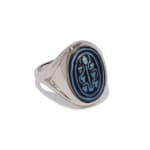

Roman
Dionysiac onyx white gold ring, Roman, circa 1st - 3rd century AD
Onyx, white gold
Length of intaglio: 1.7 cm
Ring size UK: N
Ring size UK: N
An ancient Roman onyx intaglio with allegorical motifs, set in a modern 18 carat white gold ring. The gem is composed of onyx in two layers, a black over a...
An ancient Roman onyx intaglio with allegorical motifs, set in a modern 18 carat white gold ring.
The gem is composed of onyx in two layers, a black over a lighter blue grey and engraved showing the paler band beneath the darker. The decoration is composed of a stylised thyrsus or sceptre with bunches of grapes indicating a Dionysiac subject.
The gem is composed of onyx in two layers, a black over a lighter blue grey and engraved showing the paler band beneath the darker. The decoration is composed of a stylised thyrsus or sceptre with bunches of grapes indicating a Dionysiac subject.
Provenance
European private collection, Brussels, Belgium, 1990sLiterature
The thyrsus was a fennel staff entwined by vine leaves and sometimes surmounted by a pine cone. The staff was an important attribute of the god Dionysus, and was often carried by his followers, such as satyrs and maenads.The thyrsus was a symbol of prosperity, fertility as well as pleasure and enjoyment, and is often depicted in Dionysiac scenes in sculpture and vase-paintings. For a related example see Antiken Gemmen in deutschen sammlungen, band I, Staatliche Munzsammlung Munchen, teil 3, p. 116, no. 2879.

